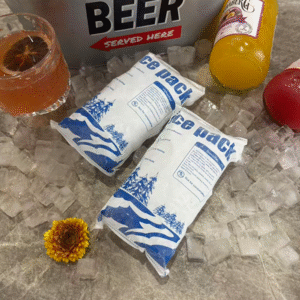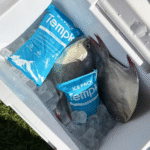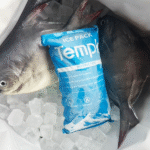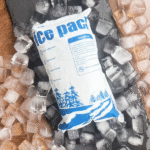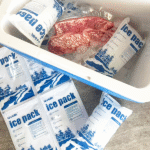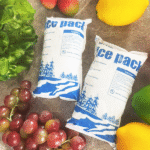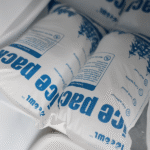Perkenalan
Dalam logistik rantai dingin, pelet es kering Dan Paket es kering telah menjadi alat pendingin yang penting untuk menjaga integritas produk dari gudang hingga tujuan. Apakah Anda mengirim vaksin, hidangan laut, atau sampel laboratorium, memilih bentuk es kering yang tepat tidak hanya menentukan stabilitas suhu—tetapi juga efisiensi operasional dan pengendalian biaya Anda.
Dalam hal ini 2025 memandu, Anda akan mempelajari cara memilih dan menerapkan solusi es kering yang sesuai dengan tujuan logistik Anda, persyaratan peraturan, dan standar keberlanjutan.
-
Itu perbedaan utama antara pelet es kering dan paket es kering
-
Kasus penggunaan terbaik di bidang farmasi, makanan, dan sektor logistik
-
Penyimpanan dan keamanan praktik penanganan es kering
-
2025 inovasi meningkatkan keberlanjutan rantai dingin
-
Bagaimana memaksimalkan kinerja pendinginan sekaligus mengurangi limbah
Apa Itu Pelet Es Kering dan Bagaimana Penggunaannya dalam Logistik Rantai Dingin?
Pelet es kering berukuran kecil, potongan silinder karbon dioksida padat (Co₂) dirancang untuk cepat, pendinginan langsung. Karena mereka menyublim—berubah langsung dari padat menjadi gas—mereka tidak meninggalkan residu cair, menjadikannya ideal untuk barang yang sensitif terhadap suhu.
Mereka banyak digunakan dalam industri di mana menjaga suhu sangat rendah sangat penting, termasuk pengiriman farmasi, Sampel biotek, Dan transportasi makanan beku.
Bagaimana Cara Kerja Pelet Es Kering dalam Prakteknya?
Pelet es kering dengan cepat menyerap energi panas, menghasilkan pendinginan intens pada -78,5°C (-109° f). Penurunan suhu yang cepat ini memastikan produk tetap beku selama pengangkutan jarak jauh. Luas permukaan pelet yang kecil memungkinkan pemerataan distribusi di dalam kotak terisolasi atau kontainer pengiriman, menawarkan cakupan termal yang konsisten.
Ikhtisar Perbandingan: Pelet Es Kering vs. Opsi Pendinginan Lainnya
| Metode pendinginan | Kisaran suhu | Lamanya | Aplikasi Ideal | Manfaat Dunia Nyata |
|---|---|---|---|---|
| Pelet Es Kering | -78.5° C. | 24–48 jam | Pengiriman sangat dingin | Tidak ada residu cair, Kontrol suhu yang tepat |
| Paket es kering | -40°C hingga -60 °C | 36–72 jam | Pendinginan jangka menengah | Sublimasi yang lebih lambat, dapat digunakan kembali, penempatan yang fleksibel |
| Paket gel | 0° C hingga -20 ° C. | 12–24 jam | Transportasi makanan yang mudah rusak | Ramah anggaran, dapat digunakan kembali |
| Bahan perubahan fase (PCM) | Dapat disesuaikan | 24–96 jam | Biopharma atau kit diagnostik | Pita suhu stabil |
Tips Praktis Menggunakan Pelet Es Kering
-
Untuk farmasi: Gunakan pelet berkepadatan tinggi pada pengirim berinsulasi vakum untuk efisiensi maksimum.
-
Untuk makanan: Letakkan pelet secara merata di bawah dan di sekitar produk untuk menghindari pencairan sebagian.
-
Untuk logistik: Gabungkan pelet dengan bahan pengubah fase untuk pengiriman multi-zona yang lebih lama.
Contoh: Pengiriman vaksin memerlukan stabilitas -70°C 48 jam mencapai hasil optimal dengan menggunakan 5kg pelet es kering 3mm dalam wadah EPS berkinerja tinggi, mengurangi risiko pembusukan dengan 40%.
Kapan Sebaiknya Anda Menggunakan Paket Es Kering Daripada Pelet?
Paket es kering adalah wadah tertutup berisi salju CO₂ terkompresi atau bubur CO₂ beku. Mereka direkayasa untuk menyediakan durasi pendinginan lebih lama dengan pelepasan uap lebih sedikit, menjadikannya ideal untuk pengiriman suhu sedang atau sistem logistik yang dapat digunakan kembali.
Keunggulan Paket Es Kering di 2025 Operasi Rantai Dingin
-
Durasi pendinginan yang diperpanjang – Hingga 72 jam suhu stabil.
-
Tidak Ada Risiko Kontak Langsung – Lebih aman bagi pekerja yang menangani pengiriman besar.
-
Desain yang dapat digunakan kembali – Mengurangi limbah kemasan dan biaya operasional.
-
Ukuran yang dapat disesuaikan – Pasang kotak berinsulasi, peti, dan palet dengan mudah.
Perbedaan Utama Antara Pelet dan Kemasan Es Kering
| Fitur | Pelet Es Kering | Paket es kering | Apa artinya bagimu |
|---|---|---|---|
| Kecepatan Pendinginan | Sangat cepat | Bertahap | Pilih pelet untuk pembekuan cepat; paket untuk pendinginan terkontrol |
| Reusability | Sekali pakai | Multi guna | Paket lebih baik untuk pengiriman berulang |
| Penanganan | Membutuhkan APD | Lebih aman untuk ditangani | Paket mengurangi paparan CO₂ |
| Biaya | Lebih rendah per kg | Lebih tinggi per unit | Tergantung pada frekuensi pengiriman |
Wawasan Kasus: Seorang eksportir makanan laut mengganti pengiriman berbahan pelet dengan paket es kering yang dapat digunakan kembali, memotong limbah kemasan dengan 60% dengan tetap menjaga konsistensi -40°C 72 jam.
Cara Menangani dan Menyimpan Es Kering dengan Aman dalam Operasi Rantai Dingin Anda
Es kering menawarkan manfaat termal yang signifikan—tetapi memerlukan penanganan yang tepat. Penyimpanan atau ventilasi yang tidak aman dapat menyebabkan peningkatan tekanan atau bahaya paparan CO₂.
Pedoman Penyimpanan
-
Simpan es kering di area berventilasi, tidak pernah dalam wadah kedap udara.
-
Jaga ruang penyimpanan di antara keduanya -80°C dan -20 °C untuk retensi optimal.
-
Hindari kontak kulit langsung; selalu gunakan sarung tangan terisolasi.
-
Putar inventaris menggunakan pertama masuk, pertama keluar (Fifo) sistem.
Tip Transportasi
-
Menggunakan wadah terisolasi dengan lubang ventilasi untuk mencegah akumulasi CO₂.
-
Lacak suhu internal menggunakan pencatat data digital atau sensor IoT.
-
Latih staf tentang prosedur darurat jika terjadi kebocoran CO₂ atau kasus radang dingin.
| Jenis risiko | Menyebabkan | Pencegahan | Dampak pada Anda |
|---|---|---|---|
| Co₂ penumpukan | Ventilasi yang buruk | Pasang kipas angin | Mencegah bahaya pekerja |
| Pencairan produk | Isolasi yang tidak tepat | Gunakan EPS atau panel vakum | Mengurangi kehilangan produk |
| Radang dingin | Kontak langsung | Gunakan sarung tangan terisolasi | Menjamin keselamatan pekerja |
Catatan Keamanan: Di dalam 2025, sebagian besar fasilitas logistik mengadopsi sensor CO₂ pintar yang terintegrasi dengan kontrol ventilasi AI untuk menjaga kepatuhan terhadap ISO 23412 standar keamanan rantai dingin.
Cara Memaksimalkan Efisiensi Pendinginan dan Mengurangi Biaya di 2025
Es kering tetap menjadi solusi yang hemat biaya dan berkelanjutan bila diterapkan secara strategis. Untuk mengurangi keduanya pemborosan energi Dan biaya bahan, perusahaan mengintegrasikan pemantauan suhu cerdas dan sistem pendingin hibrida.
Strategi Optimasi
-
Gunakan Format yang Tepat: Pelet untuk pembekuan kilat; paket untuk pendinginan yang stabil.
-
Kemasan Pra-Dinginkan: Mengurangi tingkat sublimasi hingga 15%.
-
Kombinasikan dengan Liner Terisolasi: Memperpanjang durasi pendinginan sebesar 20–30%.
-
Pantau Kerugian Sublimasi: Gunakan perangkat pelacak cerdas untuk mengoptimalkan siklus pengisian ulang.
Data Industri (2025): Perusahaan yang menerapkan sistem paket es kering hibrida melaporkan a 25% peningkatan konsistensi suhu Dan 18% pengurangan biaya bahan pendingin.
Sudut Keberlanjutan
Para pemain rantai dingin modern menyambutnya sistem pemulihan CO₂, memungkinkan produksi es kering dari emisi yang ditangkap—mendukung tujuan ekonomi sirkular dan netralitas karbon.
2025 Tren Teknologi Pendinginan Es Kering
Sektor rantai dingin berkembang pesat, dengan teknologi es kering di garis depan inovasi logistik berkelanjutan.
Kemajuan Utama
-
Pelet Otomatis: Menghasilkan ukuran pelet yang konsisten, mengurangi limbah.
-
Lembaran Es Kering yang Dapat Digunakan Kembali: Gabungkan fleksibilitas kemasan dengan daya pendinginan pelet.
-
Sensor Pemantauan Cerdas: Lacak tingkat CO₂ dan laju sublimasi secara real-time.
-
Integrasi Kemasan Berbasis Bio: Kurangi penggunaan plastik sekali pakai di kotak termal.
Wawasan Pasar Berkembang
-
Rantai Dingin Farmasi: Tumbuh di 7.3% CAGR, didorong oleh pengiriman obat biologis.
-
Pengiriman Makanan E-niaga: Ditingkatkan 35% di dalam 2025, membutuhkan solusi pendinginan kelas menengah.
-
Logistik Berkelanjutan: Lebih 60% penyedia sekarang mengadopsi sistem paket yang dapat digunakan kembali.
Pertanyaan yang sering diajukan
Q1: Berapa lama pelet es kering bertahan dalam perjalanan?
Khas, 24–48 jam, tergantung pada kualitas isolasi dan suhu eksternal.
Q2: Bisakah kantong es kering menggantikan kantong es biasa??
Ya, terutama untuk pengiriman yang membutuhkan suhu di bawah -40°C. Mereka menawarkan kinerja lebih lama dan tidak ada residu air.
Q3: Apakah es kering aman untuk transportasi udara?
Ya, tapi harus mematuhinya Peraturan Barang Berbahaya IATA (Bagian 5.5.3), memerlukan pelabelan dan wadah berventilasi.
Q4: Bagaimana saya tahu berapa banyak es kering yang harus digunakan?
Sebagai aturan, mengalokasikan 5–10 kg es kering per pengiriman 24 jam per 100 liter volume terisolasi.
Q5: Apa alternatif ramah lingkungan terbaik untuk es kering tradisional?
Pelet bio-CO₂ dan paket pengubah fasa yang dapat digunakan kembali dengan kulit luar yang dapat didaur ulang.
Ringkasan dan Rekomendasi
Pelet es kering dan paket es kering masing-masing memiliki peran berbeda dalam logistik rantai dingin.
Pelet unggul dengan cepat, aplikasi ultra-dingin, sementara paket dikirim dengan stabil, pendinginan yang dapat digunakan kembali untuk jangka waktu yang lama. Pilihan optimal bergantung pada sensitivitas produk Anda, durasi transportasi, dan tujuan keberlanjutan.
Kunci takeaways
-
Menggunakan pelet es kering untuk operasi farmasi atau flash-freeze.
-
Memilih Paket es kering untuk dapat digunakan kembali, pengiriman suhu sedang.
-
Prioritaskan pelacakan cerdas dan pendinginan hybrid untuk efisiensi biaya.
-
Mengintegrasikan sistem pemulihan CO₂ untuk operasi yang lebih ramah lingkungan.
Langkah selanjutnya
-
Audit pengaturan rantai dingin Anda – Identifikasi tahapan suhu kritis.
-
Pilih format es yang tepat berdasarkan durasi dan sensitivitas.
-
Tingkatkan ke wadah pintar dengan pemantauan termal digital.
-
Bermitra dengan pemasok bersertifikat untuk kualitas es kering yang konsisten.
Tip Tindakan: Untuk kebutuhan pengiriman yang kompleks, uji pelet dan kemasan es kering dalam kondisi terkendali untuk menentukan mana yang menawarkan rasio biaya-suhu terbaik untuk operasi Anda.
Tentang tempk
Pada Tempk, kami berspesialisasi dalam pengemasan rantai dingin canggih dan solusi pengontrol suhu yang menjaga produk Anda aman dari asal hingga tujuan.
Keahlian kami meliputi teknologi es kering, pengirim terisolasi, Dan Pemantauan suhu berbasis IoT—Dipercaya oleh farmasi, makanan, dan pemimpin logistik di seluruh dunia.
Kami terus berinovasi dengan Bahan ramah lingkungan Dan Metode produksi hemat CO₂ untuk membantu bisnis Anda mencapai sasaran kinerja dan keberlanjutan.
Panggilan untuk bertindak:
Ingin mengoptimalkan sistem pendingin Anda untuk 2025? Hubungi para ahli kami untuk saran yang disesuaikan dan analisis kinerja rantai dingin gratis.






